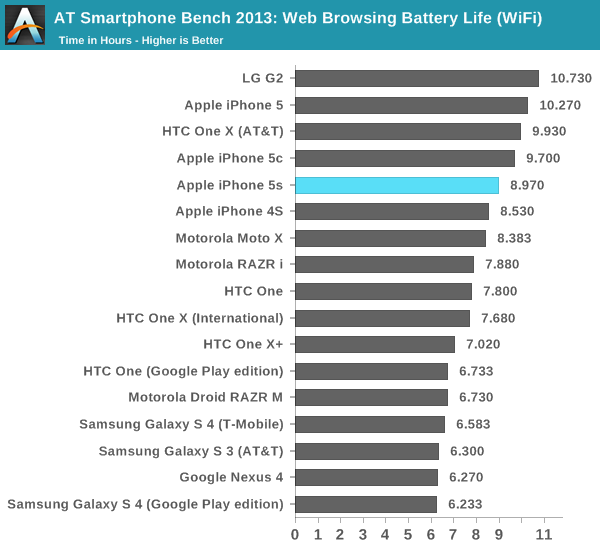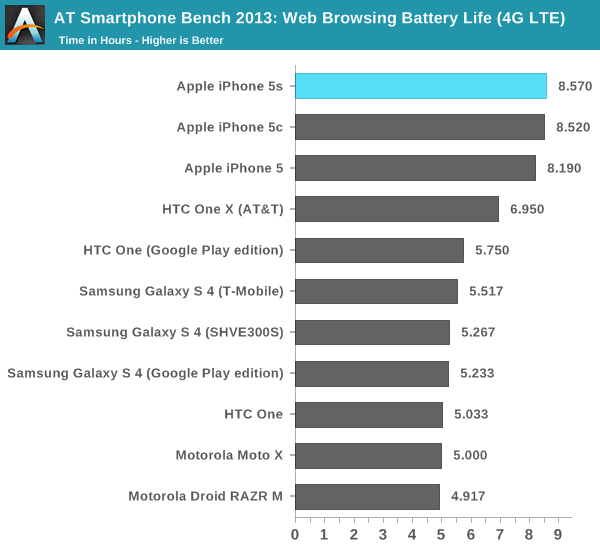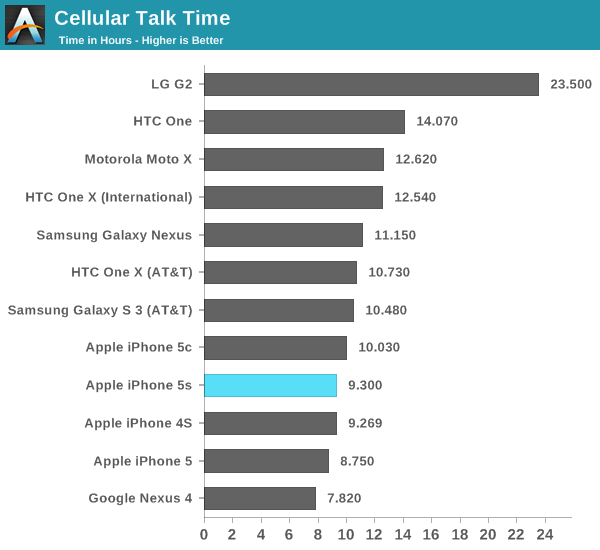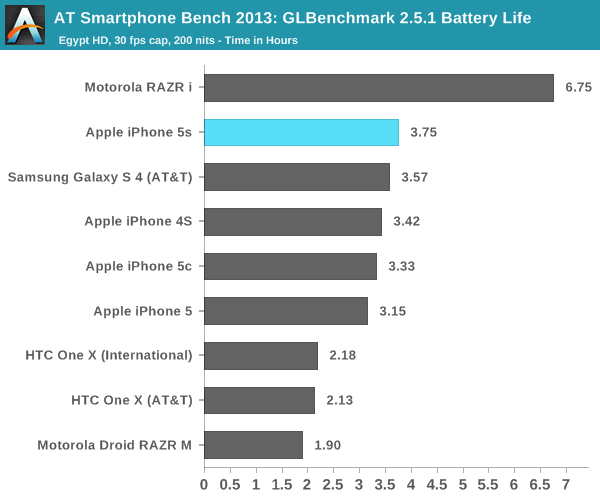The iPhone 5s Review
by Anand Lal Shimpi on September 17, 2013 9:01 PM EST- Posted in
- Smartphones
- Apple
- Mobile
- iPhone
- iPhone 5S
Battery Life
Brian did some excellent sleuthing and came across battery capacities for both the iPhone 5s and 5c in Apple’s FCC disclosures. The iPhone 5 had a 3.8V 5.45Wh battery, while the 5s boosts total capacity to 5.96Wh (an increase of 9.35%). The move to a 28nm process doesn’t come with all of the benefits of a full node shrink, and it’s likely not enough to completely offset the higher potential power draw of a much beefier SoC. Apple claims the same or better battery life on the 5s compared to the iPhone 5, in practice the answer is a bit more complicated.
Unlike previous designs, we’ve never had a half node shrink for an s-SKU. Both the iPhone 3GS and iPhone 4S stayed on the same process node as their predecessor and drove up performance. In the case of the 3GS, the performance gains outweighed their power cost, while in the case of the iPhone 4S we generally saw a regression.
The iPhone 5s improves power consumption by going to 28nm, but turns that savings into increased performance. The SoC also delivers a wider dynamic range of performance than we’ve ever seen from an Apple device. There’s as much CPU power here as the first 11-inch MacBook Air, and more GPU power than an iPad 4.
To find out the balance of power savings vs. additional performance I turned to our current battery life test suite, which we first introduced with the iPhone 5 review last year.
We'll start with our WiFi battery life test. As always, we regularly load web pages at a fixed interval until the battery dies (all displays are calibrated to 200 nits).

The iPhone 5s regresses a bit compared to the 5 in this test (~12% reduction despite the larger battery). We're loading web pages very aggressively here, likely keeping the A7 cores running at their most power hungry state. Even the 5c sees a bit of a regression compared to the 5, which makes me wonder if we're seeing some of the effects of an early iOS 7 release here.
The story on LTE is a bit different. Here we see a slight improvement in battery life compared to the iPhone 5, although the larger battery of the 5s doesn't seem to give it anything other than parity with the 5c:

Our cellular talk time test is almost entirely display and SoC independent, turning it mostly into a battery capacity test:

You can see the close grouping of the smaller iPhones at the bottom of the chart. There's a definite improvement in call time compared to the iPhone 5. We're finally up above iPhone 4S levels there.

Our Egypt HD based 3D battery life test gives us the first indication that Rogue, at least running fairly light code, can be more power efficient than the outgoing 5XT. Obviously the G6430 implemented here can run at fairly high performance levels, so I'm fully expecting peak power consumption to be worse but for more normal workloads there's no regression at all - a very good sign.










464 Comments
View All Comments
dylan522p - Tuesday, September 17, 2013 - link
Adreno has a larger thermal headroom. If Apple moves to 5" they would be able to scale performance much much higher.blanarahul - Tuesday, September 17, 2013 - link
The key word is "if". I would be really happy if they do move to 5 inch.BTW, these chips = Snapdragon 800.
tuxRoller - Wednesday, September 18, 2013 - link
Yes, though the battery performance seems quite good for snapdragon 800.robbertbobbertson - Tuesday, September 17, 2013 - link
So going off these theoretical numbers, the new iPhone 5S GPU is 4.36% as powerful as the one in the Playstation 4, and thats considered a weak GPU from the enthusiasts perspective. How is this is a "desktop" class chip. People thinking mobile will overtake everything are dreaming.dylan522p - Tuesday, September 17, 2013 - link
You do realize that a Core Duo from years back is more than enough for most people on GPU and CPU, not the PS4 or some mid or high end chip now. Desktop class was simply marketing referring to 64-bit though.ScienceNOW - Tuesday, September 17, 2013 - link
Are you kidding me? We are almost there. 4,36% is less than 5 doublings from 100% (PS4 GPU performance). In 5 years mobile GPU will be 40% MORE powerful than PS4. 8-9 years, and it'll equal todays' GTX 780lowlymarine - Tuesday, September 17, 2013 - link
Obligatory XKCD: http://xkcd.com/605/You're assuming that mobile GPU performance will continue to double each year indefinitely, which is patently absurd. There was a time each year's new desktop GPU doubled performance, too, but you reach a point where the laws of physics make that impractical.
dylan522p - Tuesday, September 17, 2013 - link
True, but mobile GPU has been doubling-trippling every year for the past like 6 years. It shows no indication of slowing down either. or dropping below doubling. No doubt though, the mobile industry will be above the PS4 performance before it's update.A5 - Tuesday, September 17, 2013 - link
A lot of that has been fueled by catching up on process tech. That party is almost over - 20/22nm class parts are still a year+ away, and ~14nm parts for anyone that isn't Intel are even farther out.melgross - Tuesday, September 17, 2013 - link
Well, if Intel's mobile line is now at 22nm, and Apple's is at 28nm, that a problem for Intel. With the A7 proving to be about equal to what Intel is producing, going by Anand's tests here, then Intel's tech isn't all that great.Indeed, Intel has always depended upon its better process fabrication, and being a generation ahead for its superior performance. It's not just chip design. So if Apple can catch up in performance being a half generation behind in node, then Apple's designs are superior to Intel's. and then, Intel had better watch out.